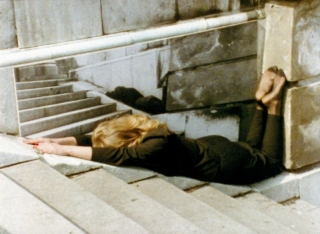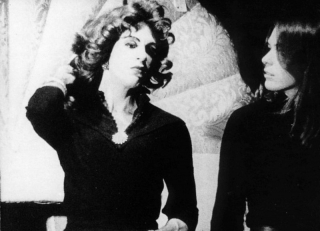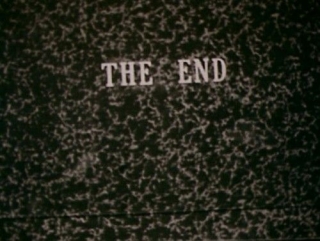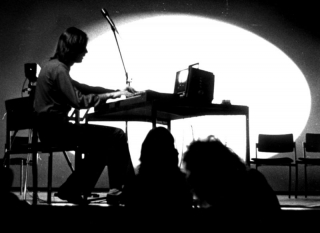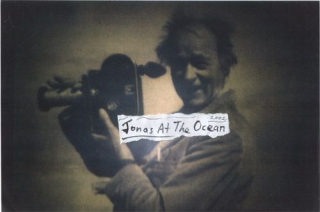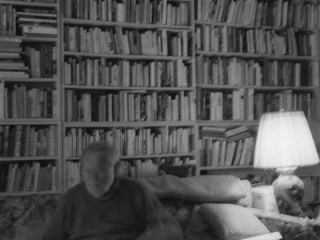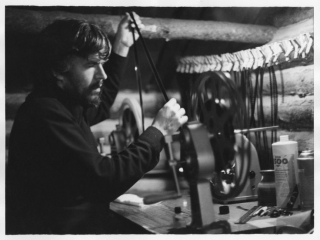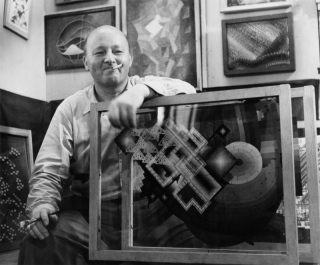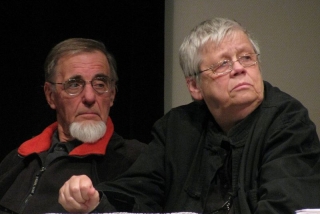Date: 3 June 2003 | Season: Essential Frame
THE ESSENTIAL FRAME: EARLY HISTORY
3 June—8 July 2003
The Essential Frame UK Tour: Programme 1
The origins of the movement, which rapidly matured into an authoritative investigation of the material of film and the formal aspects of its physical and intellectual application.
Peter Kubelka, Unsere Afrikareise, 1966, 13 min
Peter Kubelka, Schwechater, 1958, 2 x 1 min
Ernst Schmidt Jr., Filmreste, 1966, 10 min
Kurt Kren, 20/68 Schatzi, 1968, 3 min
Kurt Kren, 13/67 Sinus ß, 1967, 6 min
Hans Scheugl, Hernals, 1967, 11 min
Marc Adrian, Text 1, 1963, 3 min
Moucle Blackout, Die Geburt der Venus, 1970-72, 5 min
Valie Export, Mann & Frau & Animal, 1970-73, 8 min
Valie Export, Syntagma, 1984, 18 min
PROGRAMME NOTES
EARLY HISTORY
3 June—8 July 2003
UK Tour Program 1
UNSERE AFRIKAREISE
Peter Kubelka, 1966, 16mm, colour, sound, 13 min
“I play with the emotions and try to tear the emotions loose from people, so that they would gain distance to their emotions, to their own feelings.”
“I know of no other cinema like this. The ultimate precision, even fixity, that Kubelka’s films achieve frees them to become objects that have some of the complexity of nature itself – but they are films of a nature refined and defined, remade into a series of relationships. Those rare and miraculous moments in nature when the sun’s rays align themselves precisely with the edge of a rock or the space between two buildings, or when a pattern on sand or in clouds suddenly seems to take on some other aspect, animal or human, are paralleled in single events of a Kubelka film. The whole film is forged out of so many such precisions with an ecstatic compression possible only in cinema.” —Fred Camper
SCHWECHATER
Peter Kubelka, 1958, 16mm, colour, sound, 2 x 1 min
The material for the second of Kubelka’s ‘metric’ films came from a commission for a beer commercial. Through precise editing, the imagery is distilled down into a crystal shot of cinematic spirit.
“Schwechater lasts for one minute. It contains practically no plot, or only a negative plot. It contains elements with people who are drinking beer. This plot was enforced by external constraint. I simply was forced to film it. The plot doesn’t add any energy to the film. Nevertheless the film has an incredible visual energy. This minute possesses more visual energy than any other minute of film I have ever seen. Where does it come from? It is because I have broken with the old aesthetic, the old rules of film making, which say that film is movement. On the screen there is not any movement. Film is only the fast projection of stills.” —Peter Kubelka
FILMRESTE
Ernst Schmidt Jr., 1966, 16mm, b/w, sound, 10 min
A ‘Destruktionsfilm’ in which leftover scraps are combined using a strict system to create a rigorous, concrete film structure.
“Possibilities for making films today: film a script as badly as it is written. Produce a film with the participation of everyone. For films with more than one reel, don’t tell the projectionist which part is to be shown first. Shoot a film without an end, making it longer and longer. Make a feature film that can be played backwards and forwards. Make a silent film. Make an 8mm film. Make inter-media films. Film television. Film. Make a film in 20 one-minute parts, which is then shown with 20-minute breaks in a 7-hour screening. Apply for a subsidy from the Ministry for Education. Hang a curtain in front of the screen and project the film on it. Draw a picture on the soundtrack. With 30 projectors, show 30 films on a screen at the same time. Make a real film (with living actors). Make light shows. Make sad movies. Make expanded movies. Make movie movies.” —Ernst Schmidt Jr.
20/68 SCHATZI
Kurt Kren, 1968, 16mm, b/w, silent, 3 min
Film made from a photograph of a soldier in a field of corpses. The image is censored, obscured from view for all but a brief moment, by Kren’s manipulation of the camera.
“The source material is a photograph, found in an attic, of an SS officer in a concentration camp, surrounded by corpses. Kren lined up a positive, a negative and an over exposed transparency of the image, mounted them on a window and moved the three images against each other. This produces a blurred image, which preserves only the briefest outlines. As he had no zoom, Kren gradually moves the camera away from the transparencies, from a close up to a wide shot. The wide shot is the only moment where one can recognise the man’s image undistorted, for soon the camera moves back to the close up position.” —Hans Scheugl
13/67 SINUS ß
Kurt Kren, 1967, 16mm, b/w, silent, 6 min
A study of the body, referring both to his earlier films and the photography of Muybridge.
“The images I used are taken from a book on facial expressions and gestures. I also used images of heads from the Szondi tests, then brief shots of Venice and in Prague, taken from a tower, and in the middle, shots of the Destruction In Art Symposium in London, 1966. Mühl and Brus performed a public action there. I have never done such a thing before, mixing many kinds of material, at least not in this way. Nevertheless the film still has unity. When I watch the film, I can sense that it is right. But I can’t explain why.” —Kurt Kren, interviewed by Hans Scheugl
HERNALS
Hans Scheugl, 1967, 16mm, colour, sound, 11 min
Time and perspective are disjointed as a series of street situations are shot simultaneously from two cameras and consecutively edited together. Ambient sync sound fortifies the rhythmic cutting.
“In front of the camera: Valie Export, Peter Weibel. In Hernals documentary and pseudo-documentary procedures were filmed simultaneously by two cameras from different viewpoints. The material was then divided into phases of movement. In the montage each phase was doubled. The techniques used in this process vary. Also the sound was doubled, again using different techniques. Two realities, differently perceived according to the conditions of this film, were edited into one synthetic reality, where everything is repeated. This doubling up destroys the postulate: identity of copy and image. Loss of identity, loss of reality (e.g. schizophrenia). One has only to imagine a theater piece, where the actors recite each sentence twice, make each gesture twice, play each scene twice – and one conceives perhaps the monstrosity of our reality, which does not allow for duplications. Time is not stopped, but streched – time as fissure between copy and image, time, which creates space.” —Peter Weibel
TEXT 1
Marc Adrian, 1963, 16mm, b/w, sound, 3 min
Combinations of words appear on the screen according to a random system produced by computer. An example of Adrian’s ‘Schriftfilm’ series of text based works.
“With Text 1, Adrian explores the similarity of meaning by presenting a selection of individual words that represent the same meaning in both German and English language. Articulating these upon the black negative space, Adrian embodies them in time and the peculiar receding illusionistic space of the void with each preceding word leaving traces of itself to join with the one that follows. The revelation apparent in this film is not simply that these words are reduced to mere pictorial images at play within an illusionistic field (as each retains its own integrity of meaning), but rather the oppositional duality that each proposes occurs in a ‘post-object’ environment of reading. Quite simply, each code retains its intrinsic relationship to what it represents despite that representation occurring in two distinct forms of language (German and English). The flow of the construction of meaning emanates from Adrian’s proposition through two distinct channels – each retains a similitude in reference to the other, yet each channel of post-situationist articulation remains separate.” —Peter Mudie
DIE GEBURT DER VENUS
Moucle Blackout, 1970-72, 16mm, b/w, sound, 5 min
An underground animation of still photographs and mirror manipulations forms a meditation on sex and mortality. Soundtrack assembled from cut-up Beatles.
“The basic material consisted of about 30 photos showing some close friends, and a dead pig we had found on a road. The pictures of the pig are used as a symmetric motion-montage. I took proper and left/right-inverted photos which are moved back and forth symmetrically over the central axis. The introduction-scene shows Botticelli’s “Birth of Venus,” cross-fading the figures at both sides and following the title, also Venus with a symmetrical pig-montage. A detail of B’s picture appears at the end of the film on a wrapper of a lavoratory-deodorant (snif). Three Beatles songs emphasise the performance with their text. The pig is used as a symbol for the woman as a victim. It also stands for any associations to pig as proverbial: poor swine, filthy pig, greedy pig or it may allude to a pigsty or a pig in a poke, etc. The friends appear as two dancing women, two lovers, a cock, a sex-changing head, etc. Some of the photos were shot by Marc Adrian.” —Moucle Blackout
MANN & FRAU & ANIMAL
Valie Export, 1970-73, 16mm, b/w & colour, sound, 8 min
“Instead of the holy trinity: father, son, holy spirit, instead of the profane trinity: mother, family, state, instead of the social trinity: father, mother, children the film treats the real trilogy in 3 sections. What unites man and woman (not uniquely for sure, but what is being concealed) is the history of nature.” —Valie Export
“The earlier films of Valie Export, one feels, were motivated by the author’s desire and needs to investigate her own subjectivity, with the audience as a necessary part of the transference and polemic. Mann & Frau & Animal shows a woman finding pleasure in herself, the whole film a kind of assertion and affirmation of female sexuality and its independence from male values and pleasures. Thinking about my ‘quite erotic’ tag of that film, I realise that as a viewer I am experiencing a sexuality like that of childhood – one motivated by curiosity, a prosaic pleasure in looking, but free from fantasy. It is quite unlike the experience of ordinary pornography which is invested with the erotic almost exclusively through its symbolisation of power.” —Joanna Kiernan
SYNTAGMA
Valie Export, 1984, 16mm, colour, sound, 18 min
“Syntagma is like a rigid gaze directed at oneself as if one were two persons; staring at oneself and the camera staring at oneself. Through these two eyes only the staring can be perceived, reflections of identity, the mirror as something impenetrable, like a veil being scrutinised. The more the mirror reflects, the more it moves into oblivion like an impenetrable object even if it makes imprints of itself on pictures.” —Valie Export
“The connection of the elements of a picture implies its structure and its possibility, its form of representation.” —Ludwig Wittgenstein, Tractatus 2.15
“According to this view, the representing relationship which makes it a picture also belongs to the picture.” —Ludwig Wittgenstein, Tractatus, 2.1513
“This short film consolidates not only the great variety of avant-garde techniques accumulated over two decades of work in Expanded Cinema, video and photography, but also the insights gleaned from her body work in performances, actions and installations. At the same time, feminism both as methodology and personal experiential stance, which had left an indelible mark on Export’s art during the 1970s, continued to be the single most important impulse and thematic source in her work in the 1980s. The reappropriation of the female body from its perceived sense of alienation has been at the forefront of Export’s feminist concerns. The female body, thus perceived, is in fragments, split and ruined, lacking cohesion, “the site not only of an anatomical but of discursive lack”.” —Roswitha Müller, quoting Kaja Silverman “The Acoustic Mirror”
Back to top
Date: 14 June 2003 | Season: California Sound/California Image
HOLLYWOOD BE THY NAME
Saturday 14 June 2003, at 7pm
London Barbican Screen
Four of the avant-garde’s most momentous flirtations with the glamorous world of The Movies. The dark shadow of Tinseltown looms large on the horizon.
Robert Florey & Slavko Vorkapich, The Life and Death of 9413 – A Hollywood Extra, 1927, b/w, silent, 15 min
George Kuchar, I, An Actress, 1978, b/w, sound, 10 min
Andy Warhol, Hedy (The Shoplifter), 1966, b/w, sound, 66 min
Kenneth Anger, Puce Moment, 1949/70, colour, sound, 7 min
PROGRAMME NOTES
HOLLYWOOD BE THY NAME
Saturday 14 June 2003, at 7pm
London Barbican Screen
THE LIFE AND DEATH OF 9413 – A HOLLYWOOD EXTRA
Robert Florey & Slavko Vorkapich, 1927, b/w, silent, 15 min
“A Hollywood Extra was made by three people: Slavko Vorkapich, an expatriate Yugoslavian commercial artist turned cinéaste; Robert Florey, an expatriate French journalist; and Gregg Toland, an assistant cameraman at MGM. Shot over several weekends in Vorkapich’s kitchen at a total cost of $97, it combined live action and special effects to recount the fate of an extra who hopes to make a career as an actor, and also to sketch the conditions of studio production and the architectural fabric of the city at large. Hollywood dehumanises the hopeful actor and eventually destroys him. He is reduced to a number (which is written on his forehead), he fails to find work and, hounded by creditors and continually humiliated by the stars, he sinks into poverty and dies. Only when he reaches Heaven is the stigma removed from his brow.” —David E. James, Unseen Cinema
I, AN ACTRESS
George Kuchar, 1978, b/w, sound, 10 min
“This film was shot in 10 minutes with four or five students of mine at the San Francisco Art Institute. It was to be a screen test for a girl in the class. She wanted something to show producers of theatrical productions; the girl was interested in an acting career. By the time all the heavy equipment was set up the class was just about over; all we had was 10 minutes. Since 400 feet of film takes 10 minutes to run through the camera … that was the answer: Just start it and don’t stop till it runs out. I had to get into the act to speed things up so, in a way, this film gives an insight into my directing techniques while under pressure.” —George Kuchar
HEDY (THE SHOPLIFTER)
Andy Warhol, 1966, b/w, sound, 66 min
“Starring Mario Montez as ‘Hedy’, Mary Woronov as the policewoman, Harvey Tavel as the judge, Ingrid Superstar as the sales lady, Ronald Tavel as the walk-on, and the five husbands are played by Gerard Malanga, Rick Lockwood, James Claire, Randy Borscheidt, David Myers. Jack Smith plays the soothsayer. Arnold Rockwood, of Flaming Creatures fame, plays the surgeon. The story of a wealthy and beautiful woman getting a face-lifting to look more beautiful, and then caught at shop-lifting, to face her former five husbands and her past climbing up and down the ladder of success. Scenario by Ronald Tavel. Musical soundtrack by John Cale and Lou Reed.” —New York Film-Makers’ Cooperative Catalogue No.4
PUCE MOMENT
Kenneth Anger, 1949/70, colour, sound, 7 min
A fragment of the uncompleted feature film Puce Women. “Puce Women was my love affair with mythological Hollywood. A straight, heterosexual love affair, no bullshit, with all the great goddesses of the silent screen. They were to be filmed in their actual houses; I was, in effect, filming ghosts. When I couldn’t get any bread from [Arthur] Freed or [Gene] Kelly at MGM the project was doomed, because a freeway to the San Fernando Valley was put through all those lovely 1920 houses. That was a sad day for Hollywood, the beginning of the end, when Whitley Heights went. I’m a conservative, meaning that I cherish things of value. This places me at the antipodes of a cheap hustler like Andy Warhol, who is the garbage merchant of our time.” —Kenneth Anger interviewed by Tony Rayns
Back to top
Date: 30 September 2003 | Season: Christopher Maclaine
THE FILMS OF CHRISTOPHER MACLAINE
Tuesday 30 September 2003, at 7pm
London The Other Cinema
Jazz, dope and rebellion – four films from the hipster subculture of San Francisco, all made by obscure and elusive poet Christopher Maclaine. His masterpiece The End (1953), salvaged in the 60s by Stan Brakhage and revered by many since, is a remarkably apocalyptic post-war saga of impending doom: the last day on earth for six of ‘our friends’ living in the shadow of the A-bomb. These new prints of Maclaine’s complete films also feature alchemical incantation (The Man Who Invented Gold), existential despondence (Beat) and highland flings (Scotch Hop).
Christopher Maclaine, The End, 1953, colour, sound, 35 min
Christopher Maclaine, Beat, 1958, colour, sound, 6 min
Christopher Maclaine, The Man Who Invented Gold, 1957, colour, sound, 14 min
Christopher Maclaine, Scotch Hop, 1959, colour, sound, 6 min
PROGRAMME NOTES
THE FILMS OF CHRISTOPHER MACLAINE
Tuesday 30 September 2003, at 7pm
London The Other Cinema
THE END
Christopher Maclaine, 1953, b/w & colour, sound, 35m
Narrated by Christopher Maclaine. Photographed by Jordan Belson.
The End is a remarkable apocalyptic post-war saga of impending doom, which follows the last day on earth for six of ‘our friends’ living in the shadow of the A-bomb. Composed of six discreet episodes, the film builds an atmosphere of doom, infused with what seems now to be dark, ironic humour. Maclaine’s virtuoso, past-tense narration is a bewildering and incoherent rant against the impending holocaust, directly addressing the viewer, who is forced to become and active participant in the story. His fractured montage works against narrative logic, a self-destructive trait that mirrors the ‘grand suicide of the human race’.
The End is partly acted, with additional observational footage. These fleeting glimpses of the world around show normal lives continuing oblivious to the nuclear threat. Disjointed cutting, subverted narratives and cryptic camerawork fuse banality with purpose. This is a truly poetic use of cinema in the way it is able to transmit unspoken thoughts through an apparently random successions of images.
Dating from 1953, this may in fact be the first genuine ‘beat’ film, profoundly inventive and advanced for its time. Maclaine’s outlook is bleak and his techniques are crude, creating a film which is deliciously inept, but glorious. One of cinema’s starkest evocations of the Cold War period and its effect on creative thought, situated in the beat milieu of 1950s San Francisco but speaking in direct terms to generations of lost souls.
BEAT
Christopher Maclaine, 1958, colour, sound, 6m
A visual notebook which captures the existential angst and futility of bohemian life, evoking the despondent mood of a particular moment in American culture. The film is an abstract hide-and-seek featuring a man and woman wandering separately through the parks and streets of 1950s San Francisco. Perhaps they are escaping from their impoverished lives in search of freedom and enlightenment. She performs an invocation at an intersection and is later liberated, while he, less wilful, ends up losing his marbles at the beach.
THE MAN WHO INVENTED GOLD
Christopher Maclaine, 1957, b/w & colour, sound, 14m
Narrated by Christopher Maclaine. Photographed by Jordan Belson. Music by Christopher Maclaine and George Abend. Recorded by R.W. Emerson.
A demented fable of alchemical inquisition. Ridiculed by his neighbours, a madman works in isolation on a chemical formula for making gold. He finally succeeds after being told the secret in a dream, but his conceit drives him to get back at his sceptical friends, turning one neighbour into gold before he is punished by being turned to gold himself. Maclaine takes the central role, though many others (including filmmaker Larry Jordan) act as stand-ins throughout. The substitution of people is one of the metaphors representing the transformations in the story. The images are a complex mix of not only positive and negative black-and-white and colour stock, but also live action with abstract, scratched and hand-painted sections, while Maclaine’s rambling narration is an allegorical nonsense poem.
SCOTCH HOP
Christopher Maclaine, 1959, colour, sound, 6m
In acknowledgement of his Scottish heritage, Maclaine photographed this cine-poem to document an authentic highland gathering in the town of Petaluma, California. The pastimes include speed walking, tossing the caber, traditional dances, bagpipe and drum troops. Using unlikely camera angles and tight, rhythmic cutting, Maclaine performs an impromptu dance with the camera, cut to the tuneful droning of the pipes and drums. You can take the Maclaines out of Scotland, but you can’t take Scotland from the Maclaines.
All texts by Mark Webber, 2003
Back to top
Date: 10 October 2003 | Season: Evolution 2003
WOJCIECH BRUSZEWSKI: FILM / VIDEO / PHENOMENA
Friday 10 October 2003, at 4pm
Leeds Evolution 03 at the Leeds College of Music
Wojciech Bruszewski is one of Poland’s foremost media artists, active in the fields of theory and practice, who uses film, video, photography, computers and language to create audio-visual works and installations that frequently examine the phenomena of sight and perception.
Bruszewski was a student at the National Film Academy in Lodz, a city with a strong avant-garde history (particularly in Constructivism), and home to the only Polish museum of modern art. Here, he connected with other radical artists and, with Józef Robakowski, Zbigniew Rybczynski and Ryszard Wasko, formed the Workshop of Film Form, which conducted multimedia experiments throughout the early 1970s.
Bruszewski’s film and video works are effectively analytical investigations into the specific properties of each medium. His best-known film work is YYAA, in which changes in light exposure direct the soundtrack that is created by editing together a 3-minute long primal scream. Other works, like Tea-Spoon and Match-Box, also challenge the viewer by manipulating our expectations of synchronous sound and image. Much of Bruszewski’s early work in video examines the immediate relationship between camera, monitor and viewer made possible by instant playback or live feed technology.
The artist will be present to discuss the theories behind his works and screen examples of his pioneering films, videos and documentation of installations, plus the film performance Points.
Wojciech Brusezewski was born in 1947 in Wroclaw, Poland. Lives and works in Lodz, Poland. A practising artist and theorist since 1967. Founder of the WARSZTAT Group of avant-garde filmmakers 1970-76, made the first Polish art videotape in 1972. Exhibited at Documenta 6 & 8, Hayward Gallery, Centre Pompidou, Kölnischer Kunstverein Sydney Biennial, awarded DAAD residency in 1980. Associate Professor at Art Academy, Poznan and Nicholas Copernicus University, Torun.
Date: 15 October 2003 | Season: Miscellaneous
THE FUTURE IS NOT WHAT IT USED TO BE
15 October—22 November 2003
UK Tour
Three films by Mika Taanila, including his new documentary on the pioneering Finnish electronic music and cybernetic artist Erkki Kurenniemi, who began to build computer instruments in the 1960s. More recently, he has become manically preoccupied with achieving immortality by documenting his every thought and movement. Also screening: Futuro, about the flying-saucer shaped plastic house created by visionary architect Matti Suuronen, and A Physical Ring, a kinetic found-footage film with music by Mika Vainio of Pan Sonic.
Mika Taanila, Futuro: A New Stance for Tomorrow, Finland, 1998, 30 min
Mika Taanila, A Physical Ring, Finland, 2002, 4 min
Mika Taanila, The Future is Not What it Used to Be, Finland, 2002, 52 min
Mika Taanila will introduce the screening and answer audience questions on 16 October. Advance booking is recommended. Presented by LUX in association with The Finnish Institute and The Wire.
Wednesday 15 October 2003 (UK Premiere)
SHEFFIELD International Documentary Film Festival
Thursday 16 October 2003 [repeated Tuesday 28 October 2003]
LONDON The Other Cinema
Saturday 18 October 2003
GLASGOW CCA
Sunday 19 October 2003
BRIGHTON Cinematheque
Wednesday 22 October 2003
DUBLIN Electronic Arts Festival
Tuesday 28 October 2003
CANTERBURY Kent Institute of Art & Design
Thursday 6 November 2003
NEWCASTLE Cineside
Saturday 22 November 2003
BIRMINGHAM MAC
Mika Taanila (born 1965) has studied cultural anthropology at Helsinki University and graduated from Lahti Institute of Design, video department in 1992. Lives and works in Helsinki as free film director and video teacher at Academy of Fine Arts. Producer of new media arts in the Promotion Centre for Audiovisual Culture in Finland. Mika is a member of Team Avanto, organisers of Helsinki’s Avanto Festival of electronic arts and media.
PROGRAMME NOTES
FUTURO – A NEW STANCE FOR TOMORROW
Mika Taanila, Finland, 1998, colour, sound, 30 min
In 1968, the Finnish architect Matti Suuronen designed Futuro, a house made of plastic, which resembles a flying saucer and reflects the 1960s optimism of space travel. It was another classic of Finnish design alongside the famous ball-shaped “globe chairs” by Eero Aarnio. This film chronicles the rise and fall of Futuro during the 1970s oil crisis, which rendered the commercial manufacture of the plastic house nearly impossible. A journey back in time to our recent futuristic past, and the story of a Space Age utopia that almost came true.
A PHYSICAL RING
Mika Taanila, Finland, 2002, colour, sound, 4 min
A minimal found-footage film based on material from an anonymous Finnish physical test that took place in the 1940’s. The original purpose of the test remains unknown today. Through careful editing, inanimate research footage is assembled to a piece of kinetic fantasy. An integral part of the final work is the specially commissioned, haunting soundtrack by Ø (Mika Vainio of Pan Sonic).
FUTURE IS NOT WHAT IT USED TO BE
Mika Taanila, Finland, 2002, colour, sound, 52 min
A film about Erkki Kurenniemi, the human memory, computers and immortality. Kurenniemi is a forgotten visionary and pioneering figure in the history of Finnish avant-garde film and music, whose career represents a surprisingly natural blend of music, film, computers, robotics, science and art. He composed computer-based music and designed his own electronic instruments as early as the 1960s. His project of collecting everything around him will perhaps be the most significant of all his works. Kurenniemi records his thoughts, observations, objects and images constantly, with manic precision, with the ultimate goal of merging man and machine – reconstructing the human soul. The film looks into the past, but very clearly sees far ahead into the future through it.
Back to top
Date: 2 November 2003 | Season: London Film Festival 2003 | Tags: London Film Festival
JONAS AT THE OCEAN
Sunday 2 November 2003, at 2pm
London National Film Theatre NFT3
‘Jonas Mekas and his friends of free film, art and music.
A documentarypsychomusicfilm by Peter Sempel’
Peter Sempel, Jonas at the Ocean, Germany, 2002, 93 min
Together with his brother Adolphas, Jonas Mekas left Lithuania during World War II and eventually travelled to America as a ‘displaced person’. After settling in New York, he soon purchased a movie camera and began documenting the lives of Lithuanian immigrants. Within a few years, he was to become a central figure in the movement toward the recognition of film as art. The brothers’ arrival in New York (1949) is the film’s point of departure, and readings from ‘I Had Nowhere to Go’, Jonas’ autobiography of the period, appear throughout. Sempel loosely traces Mekas’ post-war life, as told through his interactions with other members of the arts community. There are visits with Robert Frank, Merce Cunningham and Nam June Paik, and with La Monte Young and Marian Zazeela in their ‘Dream House’. Allen Ginsberg tells the story of Pull My Daisy and the birth of beat cinema, while Phillip Glass speaks of Jonas’ independent sprit and the beginnings of the downtown arts scene in the 60s. Sempel borrows liberally from Mekas’ own films, while offering us glimpses of a life which we are more often used to seeing from his own point of view looking out.
PROGRAMME NOTES
JONAS AT THE OCEAN
Sunday 2 November 2003, at 2pm
London National Film Theatre NFT3
JONAS AT THE OCEAN
Peter Sempel, Germany, 2002, 16mm, colour, sound, 93 min
It’s actually a prolongation of Jonas In The Desert, so Part Two, but with less talking and more music. I think , feel with music you can come nearer to something , someone than with any words (of course there are also interviews, for example with Jonas, Robert Frank, Nam June Paik, Phil Glass…) I’ve been filming Jonas (not shown at all in Part One) and also new scenes as I kept on filming after 1994, actually ’til, 2001. It starts with Jonas at the seashore in Lithuania laughing and filming children and running into the water with his Bolex camera, with ‘Starlight’ by Lou Reed and John Cale (about Warhol films), his hat flies away in the wind … He reads from his book, about the days in Germany … A wonderful scene where he repeats the landing at the Hudson with Algis and his brother Adolphas (filmed in slow motion – Jonas Scholz, the cameraman did a great job!) … Him running through the wide fields of his home country, chasing cows, hugging a white horse, and running to the horizon and back into the camera … Of course also in New York, and Torino, Barcelona, Paris, Berlin, Hamburg, Sao Paulo, Washington, Montauk and … and …
Some highlights: Robert Frank in his studio, talking about the old days, a ‘light show’ with La Monte Young and Marian Zazeela, Nick Cave reads from ‘I Had Nowhere To Go’ (the scene with the peepshow in the 1950s, 42nd Street, it’s beautiful and sad. Nick reads in his little green backyard house in London, dramatically (black + white, 16mm), it’s great.) … More guests: Rudy Burkhardt talking wildly about Maya Deren, Allen Ginsberg, Julius Ziz, Kenneth Anger, Tony Conrad (with a great performance in Buffalo), Stan Brakhage, Vincent Canby, Raimund Abraham, Peter Kubelka, Michael Snow, Fernando Arrabal, Zoe Lund and Harvey Keitel, Wim Wenders (calling Jonas the James Joyce of film art …), Blixa sings a song, Kiki and more … Jonas doing an Artaud performance on the Anthology-stage, at the top of his voice … Really quite crazy he is sometimes, how wonderful! Music: from underground, classical to Lithuanian folksongs. Okay, this could give you a little idea. The whole film is 93min on 16mm. —Peter Sempel
Back to top
Date: 2 November 2003 | Season: London Film Festival 2003 | Tags: London Film Festival
FILM AS A SUBVERSIVE ART
Sunday 2 November 2003, at 7pm
London National Film Theatre NFT3
Paul Cronin, Film as a Subversive Art: Amos Vogel and Cinema 16, UK, 2003, 56 min
Speaking recently about the myriad dangers facing humanity, director-provocateur Werner Herzog cited ‘the lack of adequate imagery’ as one of the most troubling. It’s a view Amos Vogel would surely endorse. As one of America’s most important curators, historians and festival directors, his influence on artists, experimental and underground film cannot be overstated. Born in Austria in 1922 but resident in New York since 1938, Vogel created the path-breaking film society Cinema 16 in 1947, introducing a continent to previously unseen worlds of experience. 20 years on, he established the New York Film Festival and with his eye-changing book ‘Film as a Subversive Art’, penned a revolutionary analysis of the moving image. Now, in Cronin’s valuable tribute to an extraordinary man and his times, Vogel delivers a series of compelling and entertaining reflections on a life lived in the passionate belief that film has a fundamental, radical and ethical role to play in society. Required viewing for anyone who believes cinema matters. Really matters. (Gareth Evans)
followed by
Exhibitionism: Subversive Cinema and Social Change
Following the screening of Film As A Subversive Art: Amos Vogel and Cinema 16 we will be staging a panel discussion focusing on some of the key issues raised in the film.
PROGRAMME NOTES
FILM AS A SUBVERSIVE ART
Sunday 2 November 2003, at 7pm
London National Film Theatre NFT3
FILM AS A SUBVERSIVE ART: AMOS VOGEL AND CINEMA 16
Paul Cronin, UK, 2003, video, colour, sound, 56m
An hour-long profile of Amos Vogel, 82-year old New York resident and Austrian emigré, founder of the New York Film Festival and the Cinema 16 film society.
In 1947, Amos Vogel established a film club in New York called Cinema 16, the most important and influential film society in American history. At its height it boasted thousands of members, inspired a nationwide network of smaller film societies, and gave birth to the very rich tradition of post-war film culture that still exists in the United States. More than a decade before the father of modern ‘independent’ cinema – John Cassavetes – even picked up a camera, Vogel was bringing to a mass audience new ways of looking at world cinema.
The audiences of Cinema 16 were presented with a wide range of film forms, often programmed so as to confront – and sometimes to shock – conventional expectations, including works of the avant-garde, documentaries of all kinds, experimental animation, and foreign or independent features and shorts not in distribution in the United States. From the very beginning Vogel was determined to demonstrate that there was an alternative to industry-made cinema. Initially concentrating on non-fiction, he became the first programmer to show the works of Polanski, Cassavetes, De Palma, Kluge, Oshima, Ozu, Polanski, Rivette and Resnais (among many others) to American audiences. Vogel saw himself as a special breed of educator, using an exploration of cinema history and current practice not only to develop a more complete sense of the myriad experiences film culture had to offer, but also to invigorate the potential of citizenship in a democracy, and cultivate a sense of global responsibility.
Film as a Subversive Art: Amos Vogel and Cinema 16 tells the story of Cinema 16 through a vivid compilation of images and sounds, including a selection of newly filmed interviews with Amos Vogel (erudite and charismatic on-camera) and historian Scott MacDonald, author of a recent book about Vogel and Cinema 16. Vogel is filmed in various New York locations that are pertinent to the history of Cinema 16 and to New York film culture in general. There are rostrum shots of some of the photographs and beautifully designed catalogues and leaflets from Vogel’s extensive Cinema 16 archive. The film also contains excerpts from a selection of films screened at Cinema 16 between 1947 and 1963, including Roman Polanski’s Two Men and a Wardrobe, the infamous Nazi propaganda film The Eternal Jew, and the only film made by legendary New York press photographer Weegee. —Paul Cronin
Back to top
Date: 15 November 2003 | Season: Miscellaneous | Tags: Stan Brakhage
A SNAIL’S TRAIL IN THE MTRIBUTE TO STAN BRAKHAGE
Saturday 15 November 2003, at 2:45pm
Bristol Watershed
A LUX event for Brief Encounters
“Imagine an eye unruled by man-made laws of perspective, an eye unprejudiced by compositional logic, an eye which does not respond to the name of everything but which must know each object encountered in life through an adventure in perception.” —Stan Brakhage, Metaphors on Vision, 1963
Widely regarded as the most original and influential independent filmmaker of his generation, Stan Brakhage was not only a consummate artist, but also a great teacher, a passionate champion of the work of others and a huge fan of mainstream movies. His death in March 2003 brought to an end an abundant flow of imagery that produced over 300 films in five decades. His films were a search for a purity of vision unhindered by conventions of seeing. This fleeting survey of his work, including both photographed and hand-painted films, begins with a portrait of the artist made for French television earlier this year.
The curator of this event, Mark Webber will introduce this screening. Mark Webber is an independent programmer of avant-garde film and video, and is Project Manager at LUX.
Pip Chodorov, A Visit to Stan Brakhage, France, 2003, 15 min
This short documentary, commissioned by ARTE and shot in January 2003, provides an invaluable introduction to Brakhage’s work and personality.
Stan Brakhage, Autumnal, US, 1993, 5 min
In the 1990s, Brakhage concentrated mainly on hand-crafted films, usually painting directly on the filmstrip to manifest his ‘hypnagogic vision’.
Stan Brakhage, Reflections on Black, US, 1955, 12 min
During the post-war period of avant-garde psychodrama, Brakhage developed a singular approach. Reflections on Black is the most complex of his early trance films and one of his few works with sound.
Stan Brakhage, Mothlight, US, 1963, 4 min
Moth wings and vegetation were placed between strips of clear plastic to create a sculptural film without a camera. “What a moth might see from birth to death if black were white and white were black.”
Stan Brakhage, Murder Psalm, US, 1981, 17 min
Uncharacteristically for Brakhage this film is composed mostly of found-footage, which is assembled as comment on the monstrous nature of humanity.
Stan Brakhage, Ephemeral Solidity, US, 1993, 5 min
“One of the most elaborately edited of all the hand-painted films – a Haydnesque complexity of thematic variations on a totally visual (i.e. un-musical) theme.”
Stan Brakhage, Creation, US, 1979, 16 min
A journey to Alaska inspired this allegorical vision of the formation of the Earth and the emergence of life.
Stan Brakhage, Chinese Series, US, 2003, 2 min
Made by scratching with his fingernails into black 35mm film, using spit to soften the emulsion. He continued to work on this film until his death, and gave instruction that it was then to be considered complete.
Date: 5 December 2003 | Season: Oskar Fischinger
OSKAR FISCHINGER: MUSIC AND MOTION
5—9 December 2003
London Goethe-Institut
A TRIBUTE TO THE PIONEER OF ANIMATION, ABSTRACT CINEMA & VISUAL MUSIC
“Decades before computer graphics, before music videos, even before Fantasia, there were the abstract animated films of Oskar Fischinger (1900-1967). He was cinema’s Kandinsky, an animator who, beginning in the 1920s in Germany, created exquisite ‘visual music’ using geometric patterns and shapes choreographed tightly to classical music and jazz.” (John Canemaker, New York Times)
Oskar Fischinger is one of the masters of animated film and an influential pioneer of abstract cinema. Though fiercely independent and resolute, Fischinger spent periods under contract to major studios including Paramount, MGM, and Orson Welles’ Mercury Productions. During his brief tenure at Disney, he had some early involvement with Fantasia, which diluted, but popularised, many of his theories about the confluence of music and visual movement.
Born in Gelnhausen, near Frankfurt, in 1900, Fischinger trained as an engineer and, becoming interested in the newly emerging avant-garde cinema, invented a wax-slicing animation machine for creating and photographing abstract imagery. Moving to Munich and later Berlin in the 1920s, he began to make his own experimental films, participated in ‘light shows’ with composer Alexander László and did special effects for Fritz Lang’s Frau im Mond. His early, hand-drawn Studies, in which abstract or graphic shapes oscillate and transform, closely synchronised to gramophone records, were among the first examples of ‘absolute cinema’. The 1930s were successful years with public and artistic acclaim, frequent screenings and advertising commissions, leading to an invitation to Hollywood from Paramount Studios. Working with photography, silhouettes, liquids, oil painting, models and charcoal drawings, Fischinger achieved a synthesis of sound and vision, anticipating what later became the music video.
During his years in America, his unique and colourful ‘visual music’ developed through more complex techniques and innovations, and Oskar received the recognition of his peers and support from the Solomon R. Guggenheim Foundation. In later years he turned to painting as film became more expensive and problematic to produce. Fischinger died of a heart attack in Los Angeles, 1967, after which his artistic legacy was secured and promoted by the tireless work of his devoted widow Elfriede and scholar Dr. William Moritz, whose definitive biography of Oskar will be launched at this event.
Special Event – Book launch “Optical Poetry: The Life and Work of Oskar Fischinger”
Saturday 6 December 2003, at 6pm
Free drinks reception courtesy of John Libbey Publishers to celebrate the publication of Dr William Moritz’ long awaited, definitive biography of Oskar Fischinger. This book, and video tapes of Fischinger’s work released by Re:Voir, will be available for sale over the weekend.
The two programmes of films by Oskar Fischinger will also be screened at Dundee Contemporary Arts and Glasgow Film Theatre.
Please Note: This programme now travels under the title “Optical Poetry: Oskar Fischinger Retrospective” and is distributed by the Center for Visual Music.
Photograph of Oskar Fischinger © Center for Visual Music, all rights reserved.
Date: 5 March 2004 | Season: Vasulka Video
VASULKA VIDEO: PIONEERS OF ELECTRONIC ART
5—7 March 2004
London Candid Arts Trust & University of Westminster
Steina and Woody Vasulka began to use the medium of video as early as 1969, first documenting jazz performances, rock concerts and the underground activities of ‘illegitimate culture’. Exploiting the relationship between the electronic signals for both sound and image, they started a didactic exploration of the limitless possibilities of video processing using a range of newly crafted technological tools. Each tape produced was a by-product of the dialogue between the Vasulkas and their machines, as they systematically analysed and deconstructed the fundamental materiality of video through spatial, temporal and sound/image manipulation. The Vasulkas are the creative pathfinders of the electro-magnetic spectrum, whose works – infused with the fizz and crunch of the analogue age – are as mesmerising and astounding today as in their original moment of discovery.
Steina and Woody Vasulka will present three unique events during the weekend, which includes a continuous one-day gallery projection of key works.
STEINA & WOODY VASULKA: PIONEERS OF ELECTRONIC ART
VASULKA VIDEO: PIONEERS OF ELECTRONIC ART
5—7 March 2004
London Candid Arts Trust & University of Westminster
Since 1969, when they had their first access to primitive video equipment, the Vasulkas have conducted a dynamic exploration of the electro-magnetic image. Woody was born in Czechoslovakia in 1937 and trained as an engineer and filmmaker, Steina was born in Iceland in 1940 and became a professional musician. They married in 1964 and immigrated to America the following year. After seeing the ground-breaking TV as a Creative Medium exhibition at the Howard Wise Gallery in 1969, they devoted their activity to video, first documenting New York cultural events including jazz and rock concerts and underground performances using a Sony Portapak camera. Soon after, they began to experiment with using VCS3 and Buchla audio synthesisers to alter the electronic video signal, making their first image-processed tapes.
In 1971, together with Andy Mannick, the Vasulkas co-founded The Electronic Kitchen, an electronic laboratory for experimentation with sounds and images. The Kitchen soon became one of the artistic centres of New York, presenting screenings, performances and concerts ranging from the new music of La Monte Young to the new wave of Talking Heads, and it continues today as one of the city’s most prestigious multi-media art spaces.
Throughout the 1970s, the Vasulkas continued their tireless investigations into the phenomenology of video, with each tape produced being effectively a by-product of the dialogue between them and their machines. Steina and Woody did not create their images from video synthesisers; their unique approach involved the processing of previously recorded material through a series of modular units, frequently using the input of a separate electronic signal to control the effects.
Working in collaboration with creative engineers including George Brown, Bill Etra and Eric Siegel, they developed a new range of tools and devices with which they can further investigate the image. Their arsenal of analogue equipment contains the Rutt/Etra Scan Processor, Dual Colorizer, Multikeyer, Programmer, Horizontal Drift Variable Clock and the Field Flip/Flop Switcher. Much of their work explores and exploits the similarity of the sound and image signals, producing a mesmerising range of synaesthetic video before the onset of the digital age.
In 1973, the Vasulkas moved to Buffalo to teach at the Media/Study Center, where they become part of a faculty including filmmakers and theorists Tony Conrad, Hollis Frampton and Paul Sharits. The pair also began to work individually during this time. Steina embarked on the Machine Vision series, developing mechanical systems to control the camera, distancing it from the human viewpoint. Woody began to explore the digital realm, custom-designing the Digital Image Articulator. Both subsequently worked on interactive projects and large-scale installations, adding a sculptural or monumental element to their practice.
As pioneers of video art, Steina and Woody Vasulka stand alongside Nam June Paik, Peter Campus and Joan Jonas, with the Kitchen and their own studio as much a point of focus as the early activist groups Video Free America, Raindance and Guerilla Television and the innovative American television laboratories of NCET, WNET and WGBH. This weekend of events is the first opportunity in decades to see a substantial collection of the Vasulka’s early works in the UK, and a rare chance to hear the exuberant and vivacious duo discuss their work from a practical, rather than theoretical, point of view.
Back to top
